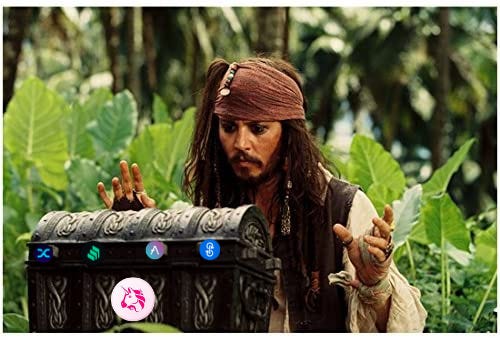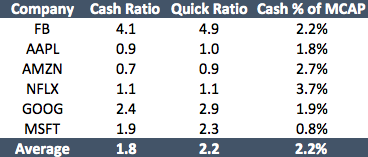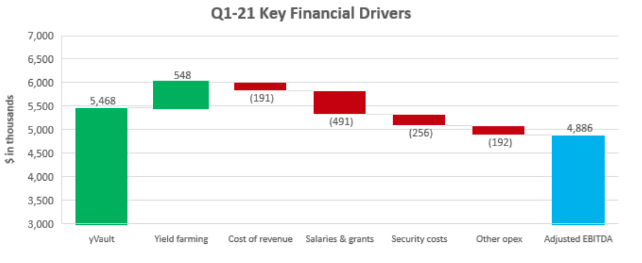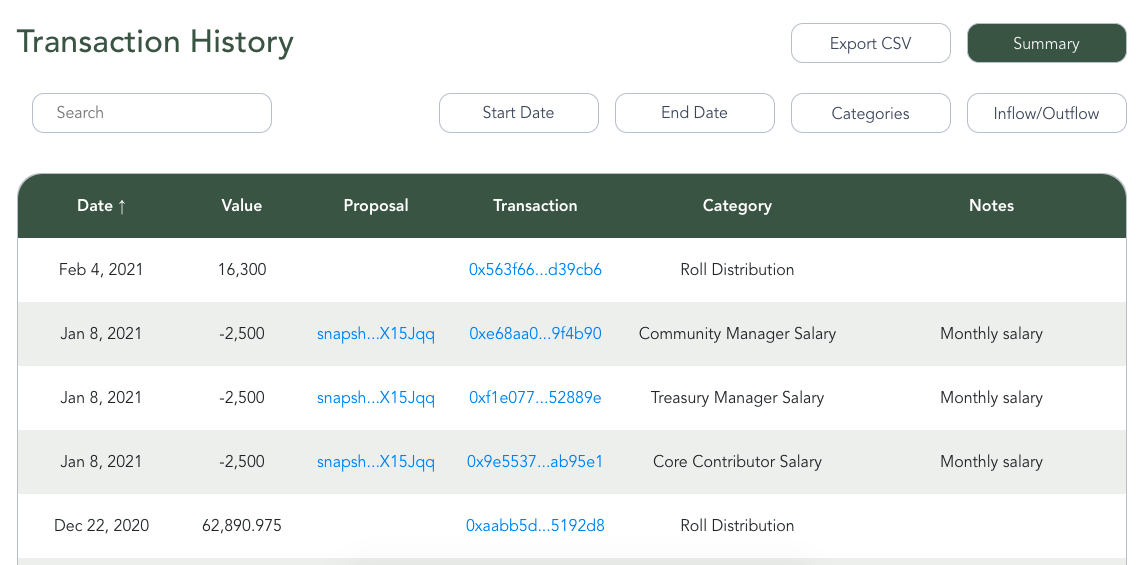How DAOs should approach treasury management

Dear Bankless Nation,
DAO treasuries are massive these days. A lot of them hold billions of dollars in capital.
So a DAO community may ask…
How do we manage the money? What deserves treasury spending and what doesn’t? How should we diversify the treasury’s assets? Should we borrow capital?
Most DAOs are still figuring this out. The best practices are being written. We’re all exploring this new frontier together.
But there’s one thing for sure: DAO treasuries are massive.
So how should DAOs approach treasury management?
That’s what Shreyas explores today. He’s helping DAOs manage treasuries effectively, so they’re well-equipped to handle any market conditions and maximize the capital on hand.
Learning how DAO’s are spending and allocating will help you identify opportunities to work for them.
This is the future of treasury management.
- RSA
P.S. Dollars to DeFi in one tap…now in all 50 states! Go download the Dharma App!
📺 This Week’s AMA: Alchemix with Scoopy Trooples
📺 Watch the Episode | 🎙️Listen To Podcast
THURSDAY THOUGHT
Guest Writer: Shreyas Hariharan, Founder of Llama
The Future of On-Chain Treasury Management
DAO treasuries have grown significantly over the past year. The top protocol DAOs have over $14B in combined treasury assets. So what should treasuries do with these assets? To answer this, we need to understand the purpose of a treasury.
Anything in a DAO that can be automated should be. Anything that can’t be automated should be funded by the treasury. Treasuries help DAOs fund critical development, attract contributors, and grow their network.
They are a vehicle to express the values of a DAO and increase its longevity.
Principles of Treasury Management
- Maintain an infinite time horizon: The treasury should be structured to exist in perpetuity (however, treasuries may be dissolved in certain situations).
- Ensure inflows exceed outflows: Over the long run, revenue from the protocol plus returns of the treasury should exceed spending.
- Diversify: Treasury allocations should ensure that critical expenses can be funded even if the protocol token has a significant drawdown.
Diversification is an important area to focus on at the moment given that the entirety of most treasuries are held in their native tokens. If UNI’s price falls by 40%, its balance sheet would also shrink by 40%. If this drop in price were to occur at a time when the protocol might need to ramp up spending—whether it is LP subsidies, token buybacks, core development, or M&A—this could lead to a further downward spiral for the token.
A protocol treasury should help grow the network. If managed well, the treasury can serve as a strategic asset that improves the protocol’s market position. If a treasury becomes significant enough, it can fund important public goods, including things in the physical world.
There are four functions to help manage DAO treasuries:
- Spending
- Asset allocation
- Borrowing
- Reporting
I will explain how each of these functions will evolve over time.
🗒️ Note: Some points in this post are more relevant to larger protocol DAOs. The last section covers treasuries of creator and curator DAOs.
I. Spending
The goal of treasury spending is to reward core contributors and attract the right set of new contributors.
Grants Programs
For protocols that have a core team doing most of the development, grants programs help empower a wider network of developers. Uniswap, Compound, and Aave have proposed grants programs that aim to fund individuals and teams that contribute to the protocol.
For example, at Aave Grants DAO, we are looking to fund a Risk Committee that will evaluate new asset listings, monitor reserves, and assess the liquidity of the protocol. This committee will consist of individuals and organizations that have expertise in smart contract audits, actuarial science, legal analysis, and risk modeling.
Committees and DAOs
The next step is for current grant recipients, i.e. individuals, committees, and DAOs, to be part of the decision making for future treasury spending. Committees will make allocations to individuals and sub-committees within their mandate.
For example, Aave’s Risk Committee will get a treasury allocation from Aave Grants DAO that they can choose to allocate however they see fit within the risk mandate. They can hire Gauntlet for a project or fund a specific risk related bounty.
This expands decision making authority to more of the right kinds of people, i.e. proven contributors, without sacrificing too much efficiency.
Decentralized Treasury Spending
Treasury allocation power in protocol DAOs should eventually be distributed to contributors based on the reputation they have built. Individuals and groups who've contributed should have more allocation power. Grant programs are the first step to find and seed these contributors.
Decentralized treasury spending lets contributors select team members they’ve worked with, allocate points to members, generate a contributor graph, and get paid based on their contributions. This is exactly how Coordinape from Yearn is designed to work.
Other models for decentralizing treasury spending include:
- Pioneer: builders vote on their peers’ projects, which generates a leaderboard based on votes weighed by credibility of voters
- WRITE race by Mirror: individuals and DAOs vote on who should get access to publish on Mirror; writers who are already on Mirror have more votes to allocate
Projects like Yearn that already have a more decentralized and bottom-up work structure will have an easier time transitioning to decentralized treasury spending than projects that have a centralized core team that doesn’t get paid from the community treasury.
II. Asset allocation
The goal of asset allocation is to ensure that the treasury can continue to fund critical development irrespective of the market environment.
Diversification into Stablecoins
The first priority for many large protocol treasuries is to diversify a portion of assets into stablecoins. The stablecoin allocation should at least cover a few years of operating expenses for the treasury.
Diversifying into stablecoins provides a protocol DAO with the following benefits:
- Maintain or ramp up spending in the event of a significant market drawdown
- Allow governance contributors, grant recipients, and security bounty recipients to be fully or partly paid in stablecoins
- Enable yield-generation on Yearn, Aave, and Compound
- Provide liquidity on stablecoin-stablecoin pools
One of the problems with diversifying into stablecoins is that it requires selling native protocol tokens. There could be a negative perception around this as well as price impact on the sale. However, this downside can be mitigated with the following:
Diversify a small portion of the total treasury. For example, Uniswap could diversify <0.5% of its fully vested treasury. And as a comparison, here are cash stats for FAANG+M companies:

Cash ratio = cash / current liabilities | Quick ratio = (cash+marketable securities+accounts receivable) / current liabilities Execute the transaction in a way that helps receive the best price and minimizes chances of getting front run. Gnosis batch auctions are an effective way to diversify a treasury on-chain and trustlessly, without getting front run.
Diversify the treasury without selling native tokens:
Earn revenue with stablecoins
Aave’s Reserve Factor accrues protocol revenue in stablecoins like USDC and DAI as well as aTokens, which are interest bearing assets.
Token swaps with other treasuries
Eventually, we’ll see on-chain money market fund products that help treasuries allocate to stablecoins and optimize yield. For example, the Stable Yield Index proposed by Index Coop is a product that aims to generate the highest risk adjusted stablecoin return.
Token Buybacks, Incentives, Liquidity Provision
Treasuries should buyback tokens when they trade at a significant discount. Yearn has a policy with YIP-56 to periodically buyback YFI with a portion of protocol earnings. They recently executed a purchase of 28 YFI for $1.2 million at an average price of $41,621 per YFI.
Treasuries currently provide incentives for liquidity mining; more such incentive schemes can be initiated by treasuries. Treasuries can also be a liquidity provider across multiple protocols and earn fees for doing so.
M&A, Investments, Insurance
M&A can improve a protocol DAO’s competitive positioning. A decentralized exchange might want to get into lending and find that M&A is more effective than internal development. Since NFTs can hold other assets, an NFT could own a DAO’s multisig treasury and its assets. DAOs could bid on specific NFTs that represent DAO assets.
M&A requires work. Specialized M&A advisory DAOs could help with:
- Valuation of DAO assets and intangibles
- Best way to finance acquisition, i.e. ideal combination of debt, tokens, and stablecoins
- Negotiation of terms with governance and large stakeholders
- Execution of protocol level merges when token holders of both communities approve the merger
Treasuries could make early investments in promising projects that emerge from grants programs. What if Uniswap’s treasury invests in the next Uniswap?
Treasuries can start to diversify into bluechip crypto assets such as BTC and ETH. Currently, most crypto assets are correlated. Assets that aren’t correlated are stablecoins, fixed income products, and on-chain gold proxies. As more uncorrelated assets gain liquidity, it will be useful to create an on-chain risk-parity portfolio.
Treasuries could also consider purchasing insurance or short-dated put options that can help the protocol during Black Swan events like contract hacks, economic exploits, and market drawdowns.
III. Borrowing
The liabilities side of treasury balance sheets is largely un-utilized.
As there's more clarity on spending and asset allocation for protocol treasuries, the next area of focus will be treasury liabilities. This includes fixed rate secured loans, unsecured loans for highly rated treasuries, bond issuance, and protocol to protocol lines of credit. When the conditions are right, treasuries should borrow.
Do treasuries need to sell or distribute protocol tokens to spend? Treasuries can consider depositing their collateral into Yield, Alchemix, or Maker and borrowing against it.
Here are few use cases for protocol borrowing (h/t Allan of Yield Protocol):
- Fund development and operations
- Fund protocol acquisitions (e.g. proposal for Inverse Finance to acquire Tonic)
- Fund yield farming with debt rather than tokens
In what cases should treasuries borrow instead of spend native tokens?
- Governance rights: prevent distributing ownership and voting rights to stakeholders that don’t benefit the protocol over the long-term
- Cheap cost of financing: funding expenses via debt at certain rates can be cheaper than via tokens
- Contributor payments: make a bulk of contributor payments in stables while long-term contributors are partly paid in vested protocol tokens
- Compounding: prevent harming treasury returns by giving away tokens at inopportune times
IV. Reporting
DAO treasuries are typically thought to be transparent. But if you need to spend several hours digging through Etherscan, Discourse forums, and voting tools to get a summary of the treasury’s activities, is the transparency useful?
Yearn’s Q1 2021 report is an excellent example of useful treasury disclosure. It contains an income statement, balance sheet, key revenue drivers, operating expenses and salaries, and priorities for the protocol.

But how can we produce these statements such that they can be verifiable with on-chain data? MakerDAO produced real-time P&L and balance sheet data using Dune Analytics. The next step is adding relevant governance voting and discussions for context. For example, every large treasury transaction should have an associated “receipt” in the form of an on-chain or off-chain vote.

We need an on-chain SEC Edgar so it’s easy to access financial statements and disclosures across all DAOs.
Recruiting
The process of recruiting people at DAOs to perform various treasury functions is unclear. You either have to do a lot of upfront work and share your interest on the governance forum or reach out to specific DAO leaders. To attract top talent, the process to contribute should be streamlined.
For example, at Llama, we onboard and train the best people to work at DAO treasuries and curate the best treasury opportunities for these people. These include opportunities for treasurers, asset managers, developers, analysts, accountants, grant reviewers, operations personnel, and index methodologists.
Creator & Curator DAOs
Most of what has been outlined so far applies to protocol DAOs though there are of course parallels to other DAOs. Creator and curator DAOs are especially interesting because they are cultural organizations. In addition to their native tokens and stablecoins, their treasuries will hold NFTs and social tokens.
Crypto enables the financialization of (almost) everything, including digital art, memes, and stories. Culture will be at the center of investing. Some of the best investors over the next few decades will deeply understand and influence culture. These will be creator and curator DAOs like FWB and WHALE.
Here are a few things creator and curator DAO treasuries can do:
- Distribute tokens to select tastemakers, e.g. holders of cryptopunks
- Curate / recruit new creators to their community by buying their NFTs
- Swap tokens with similarly aligned communities and provide access to mutual benefits like gated content or a tokenized group chat
- Airdrop tokens to the most active community members on Discord
- Facilitate an active tipping culture among members to grow the community economy
Conclusion
Treasuries help DAOs fund critical development, grow their network, express their values, and increase their longevity.
It's an exciting time to work on governance and treasury management—it’s still so early. The templates for how to structure and use treasuries are being created right now.
The future is wide open for those that want to get involved.
Action steps
- Explore the future of treasury management
- Start working for DAOs!
Author Bio
Shreyas Hariharan is the founder of Llama, which helps DAOs manage their treasuries. He is working on a treasury strategy for Uniswap and leading Aave’s grants program. If you are interested in opportunities to work with DAOs on treasury management, DM him on Twitter.